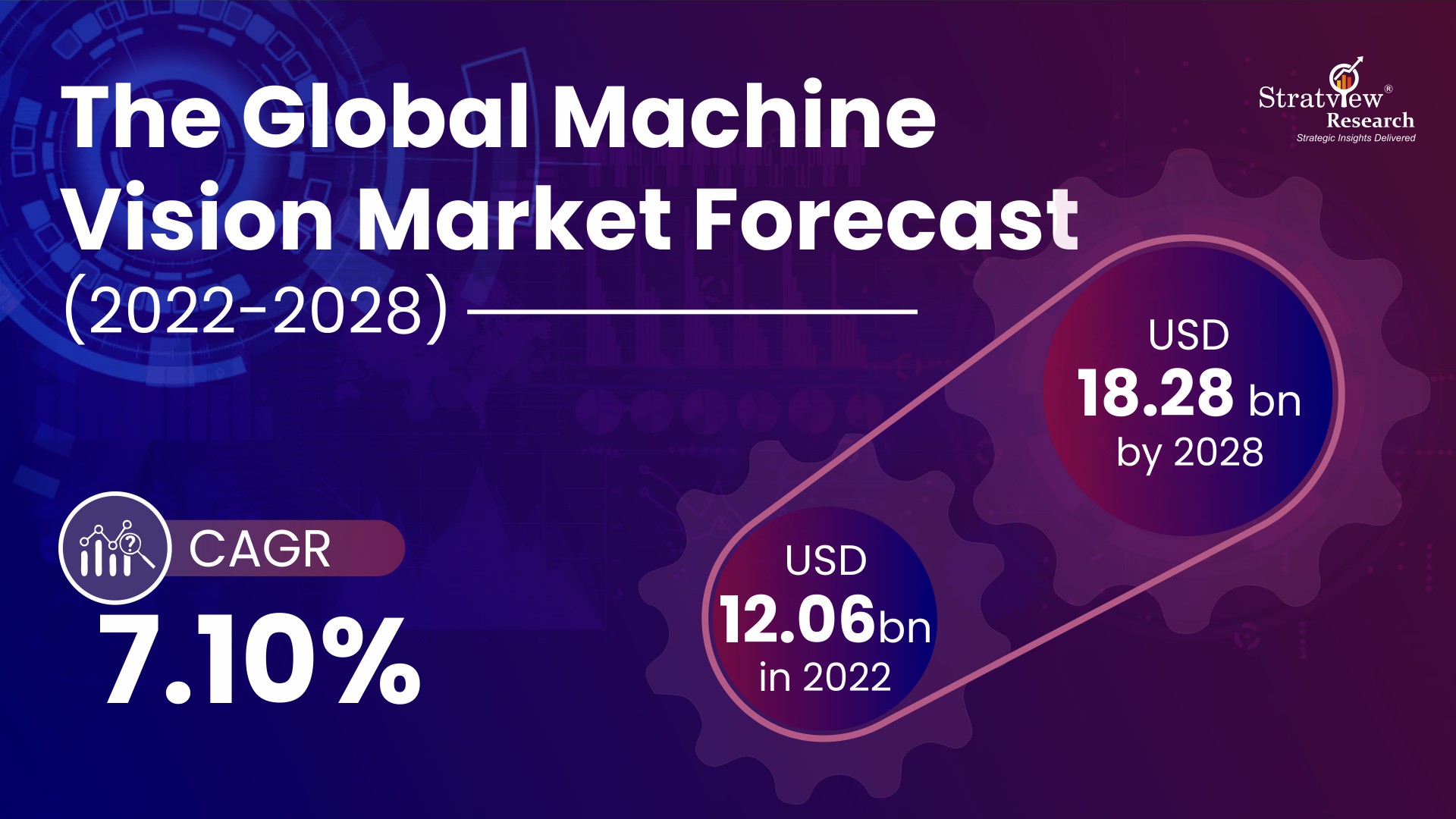For millennia, technology has reshaped our perception of the world. From the invention of the stone mirror some 8,000 years ago to the latest facial recognition trend, our understanding of sight has evolved. It is quite certain that advancements in technology will allow us to see more of this world, beyond the limits of the human eye.
Machine vision is one such technology, that is rapidly evolving with immense potential to impact our daily lives. This technology allows face recognition, enhances photos right after they are clicked on smartphones, alerts any movements in the vision zone, and even monitors the quality of food served on your plate. Its impact extends far beyond daily life, as it is considered one of the founding technologies of industrial automation.
The world’s first and fastest brain-inspired vision chip is one of the recent examples of how machine vision brings human eye-like perception to machines and leads to the development of various novel applications. Created by scientists from Tsinghua University – China, this chip is capable of sensing 10,000 frames per second, reducing bandwidth by 90%, and reducing power consumption.
There are already a huge number of real-world applications for machine vision technology and as humans and machines continue to collab, machines will take over tasks requiring imagery analysis and interpretation, freeing up the human workforce to focus on other vital tasks.
The Convergence of Machine Vision and Emerging Technologies
If we have to name the leading technologies that are driving the Industry 4.0 revolution, they will be Artificial Intelligence (AI), Machine Learning (ML), Augmented Reality (AR), Virtual Reality (VR), Internet of Things (IoT), and Robotics. During the last five years, we have witnessed a huge leap in advancements in these technologies, with AI holding the center stage in global investments.
Research shows that AI has the potential to contribute up to a whopping $15.7 trillion into the global economy by 2030. The greatest gains from AI are likely to be in industries like automotive, agriculture, retail, education, and healthcare.
A closer look at Venture Capital (VC) investments reveals a diverse landscape in AI across different countries. According to the Organisation for Economic Co-operation and Development's AI policy observatory – OECD.ai, in the U.S., VC investments in AI totalled $290 billion over the last 5 years, transforming developments across key sectors such as autonomous vehicles, healthcare, and IT infrastructure (ranked by VC investment, with the highest funded first).
Irrespective of the industries, there is an increasing preference for visual data, and this as a result, expands the scope of machine vision. Virtual try-on shopping, interactive gaming, interior recommendations, etc. are a few examples of how MV coupled with AR is enhancing our experiences.
MV solutions find their applications in industrial applications too. Take industrial robots for instance. Vision-guided robots are not new. These robots are a large selection of robotics, with integrated vision-based systems. MV expands the role of robots in performing autonomous tasks, such as picking, sorting, placing, etc. The combination of MV and robotics improves operations in different environments, such as supermarkets, hospitals and restaurants. According to the International Federation of Robotics (IFR), annual robot installations exceeded 553,000 units in the year 2022, and witnessing an upward trajectory, the installation numbers will cross 700,000-unit mark in 2026.
The convergence of machine vision with other emerging technologies has been a key driver of automation, since this convergence amplifies the capabilities and functioning of machines, propelling humans towards Industry 4.0.
Machine Vision in Practice –
The convergence of machine vision with other emerging technologies is solving some real-world problems of different industries. From creating safer work atmosphere to optimizing traffic flow, one can find MV systems in various applications such as object detection, controlling robotic systems, finding/locating things, counting people/products, detecting suspicious activities, and more.
Let’s have a look at a few prominent examples of how MV is transforming industries.
- Automotive Industry: The automotive industry is rapidly progressing towards autonomous vehicles, with Advanced Driver Assistance Systems (ADAS), lane assistance, blind spot detection, and heads-up displays already in use. MV is considered the bedrock of the transformative future of autonomous vehicles. These vehicles use various sensors, including cameras, etc. to perceive surroundings, road signs, and more.
McKinsey report states that, by 2035, autonomous driving could create $300 billion to $400 billion in revenue. MV integration is expected to reach unprecedented levels, enabling advanced perception and decision-making for enhanced safety and efficiency in the autonomous driving future.
- Healthcare Sector: The healthcare industry is challenged by a huge amount of data, and according to research,~90% of all healthcare data comes from medical imaging. Such a staggering amount of imaging data presents a huge opportunity for the machine vision industry to develop advanced algorithms for automated analysis, enhancing efficiency in the healthcare sector.
The medical industry leverages MV in various applications, one of which is medical robotics. A new approach to coronary artery bypass graft (CABG) surgery is one such live example highlighting the capabilities of medical robots. CABG is being performed at UH Cleveland Medical Center using the Da Vinci robot.
Da Vinci, a surgical robot that uses a 3D high-definition vision system to give surgeons a clear view (10X of what the human eye sees) of surgical area, gives the surgery a minimally invasive approach, as well as reduces post-operative pain and length of stay in the hospital.
- Smart Manufacturing – Manufacturing and industrial business operations are being transformed through the convergence of various technologies. In the manufacturing sector, MV serves as a sentinel of quality assurance, precisely improves product quality and overall system efficiency, reduces labour costs, and even more. For example, Audi has integrated predictive analytics and machine learning algorithms with integrated MV into weld inspection and quality control at its Neckarsulm plant, resulting in a 30%-50% reduction in labor costs. This has also allowed the car manufacturing giant to analyze more welds per day, reduce factory costs, and shift to proactive monitoring to avoid problems.
- Agricultural Automation – The projections from the Food and Agriculture Organization of the United Nations (FAO) show that food production has to increase by some 70% between 2005 and 2050. MV proves to be a helping hand for farmers, by providing real-time visual data to monitoring systems. NVIDIA's venture arm – NVentures, for example, has invested in Carbon Robotics, whose AI-powered LaserWeeder will leverage 24 NVIDIA GPUs to process 4.7 million high-rez images/hour for precision weed control. The system, proven by top farmers, leverages a dataset of 25 million labelled plants and 30,000 crop/weed models for 80% cost reduction and yield/quality increase. This investment highlights AI's transformative potential in agriculture, automating weeding with advanced computer vision and robotics.
- Traffic management – MV systems analyze traffic flow, detect violations, optimize traffic signal timings, save time, provide better traffic management, and improve traffic safety. On a mission to digitalize the backbone of transportation, NoTraffic – a mobility management firm is all set to provide state-wide AI-based traffic management systems to the Florida Department of Transportation (FDOT). This AI-powered traffic management system will optimize traffic flow, reduce congestion, and improve safety leveraging the potential of computer vision. After approving this implementation, Florida becomes the first US state to adopt a statewide AI-based traffic management solution.
- Other prominent Industries – There are several appliances in our daily life that leverage MV technology. Smart security cameras, robotic vacuum cleaners, smart lightings, educational robots, classroom monitors, etc. use MV technology, and even schools, hospitals, and other organizations are now adopting touch-free face-recognition attendance systems.
Challenges in Flawless Vision
Our world is brimming with visual information, and machines are starting to ‘see’ things. The growing exchange of visual data also poses significant challenges in terms of cybersecurity and data privacy.
Increasing the risk of cyberattacks on manufacturing industries, industrial machine robots, and other devices is yet another challenge that cannot be shelved. The 2023 analysis of Armis’ proprietary data depicts an alarming fact that global attack attempts in the manufacturing industry increased by ~165%, mostly targeting imaging devices, communications devices, manufacturing devices, etc.
Also, unlocking the true potential of MV technology necessitates skilled professionals, and informed users. MV systems although proven to improve industrial efficiency, require significant financial investment and professionals to operate. As technology adoption increases, such challenges are likely to subside with increased awareness and training.
Bridging the Gap Between Human Perception and Technological Capabilities
More than a centennial passed between the first three industrial revolutions – Industry 1.0 – 1784 till Industry 3.0 – 1969. More than 40 years passed from the third to the Fourth Industrial Revolution (2011). But trends today show that it won’t take those many years for us to transit towards the Fifth Industrial Revolution (Industry 5.0) which refers to smart machines working alongside people.
Emerging technologies including AI are being adopted at a pace seen never before. The global market for AI, for instance, is expected to top USD 700 billion by 2028 growing almost ten-fold from 2021, as per Stratview Research. This will change the way we see and do things at an unprecedented pace. The impact they will create on mankind cannot be quantified.
The rise in such technologies is likely to create a derived demand for machine vision for numerous applications such as smart homes, traffic control systems, surveillance, etc. In the medium term, the global market for machine vision is expected to cross USD 20 billion by 2030, according to Stratview Research.

As industries continue their relentless march towards greater automation and the seamless integration of human and machine intelligence, machine vision, as one of the key enablers, will have a prodigious growth opportunity in the coming times.
Authored by Stratview Research, originally published on IMVEurope.







